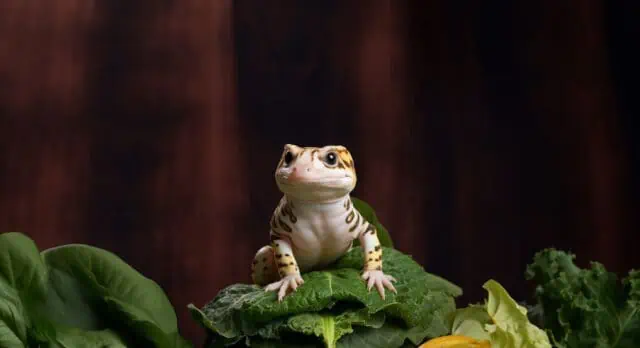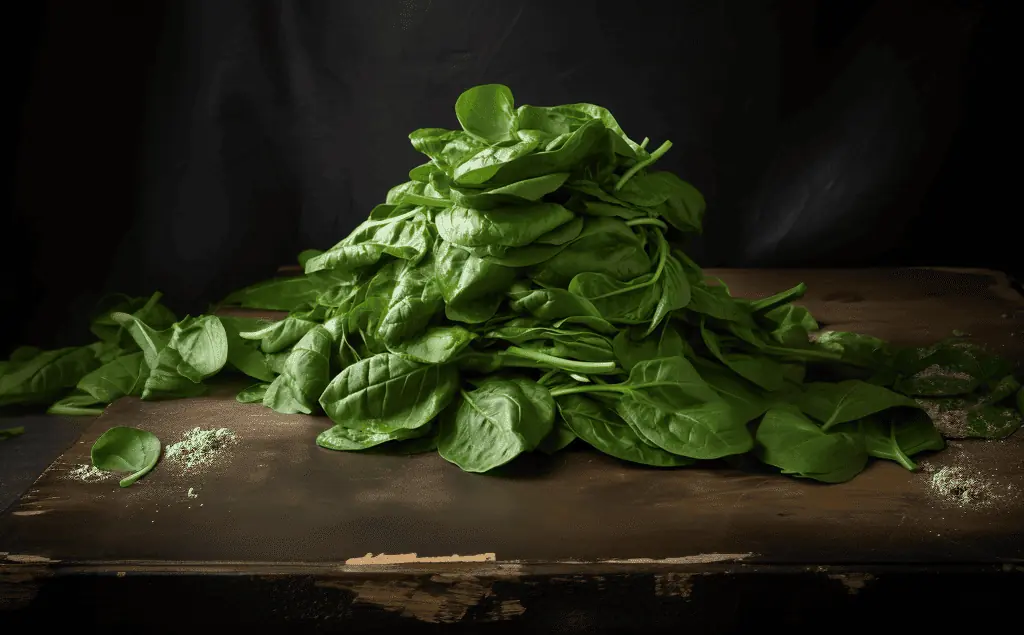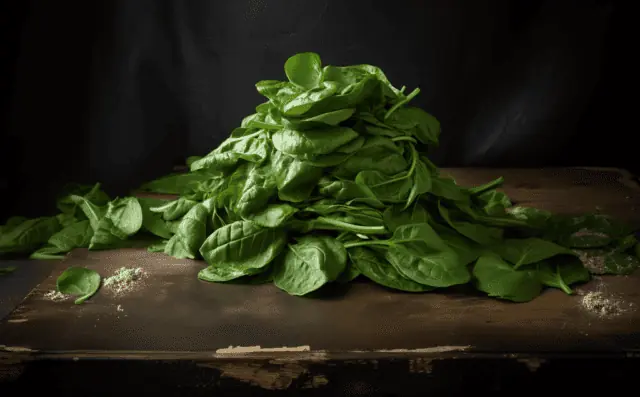Leopard geckos cannot eat spinach. In fact, they exclusively consume insects and are unable to properly process vegetables and fruits. This might come as a surprise to many, especially when we see other pets munching on greens. But for our little leopard friends, it’s a strict no-go.
Moderation is Crucial: Leopard geckos can consume spinach, but due to oxalic acid, which hinders calcium absorption, it should be given in moderation – a small piece (the size of their head) once every two weeks is a safe guideline.
Nutritional Balance: While spinach provides vitamins like A and C, it’s vital to balance your gecko’s diet with alternative foods like crickets, mealworms, and occasionally, fruits like strawberries to ensure they get all necessary nutrients without the risks of oxalic acid.
Avoiding Health Risks: Excessive spinach can lead to metabolic bone disease due to the interference of oxalic acid with calcium absorption. Always observe your gecko for any signs of distress or health issues and consult a vet if needed.
Alternative Foods: Consider other food options like dubia roaches, waxworms, and earthworms to provide a varied and nutritious diet, ensuring your leopard gecko receives essential nutrients without the potential risks that come with spinach.
Importance of a Varied Diet: A diverse diet, not heavily reliant on spinach, ensures optimal health, and longevity for your leopard gecko, providing them with the necessary nutrients for growth and vitality.
Can Leopard Geckos Eat Spinach?

The simple answer is no, leopard geckos should not eat spinach. While many animals benefit from a varied diet that includes both meat and plants, leopard geckos are not among them. Their dietary needs are specific, and feeding them spinach or any other vegetable can lead to health issues.
Risks of Feeding Spinach to Leopard Geckos
Feeding spinach to leopard geckos poses several risks. Firstly, these reptiles are not equipped to process vegetables, including spinach. Their digestive system is tailored for an insect-based diet, and introducing vegetables can disrupt their natural digestive process.
Another significant concern is the presence of oxalic acid in spinach. This compound can bind with calcium, a vital nutrient for leopard geckos. When oxalic acid binds with calcium, it prevents the geckos from absorbing it. This can lead to a condition known as metabolic bone disease, a serious ailment that affects the bone health of reptiles.
| Fact | Detail |
|---|---|
| Dietary Needs | Leopard geckos are insectivores and can’t process vegetables. |
| Oxalic Acid in Spinach | Binds with calcium, hindering its absorption. |
| Resulting Condition | Metabolic bone disease due to lack of calcium absorption. |
Can Leopard Geckos Eat Other Vegetables or Fruit?
Leopard geckos are unique in their dietary needs. Unlike some other geckos that might be omnivores, leopard geckos are strictly insectivores. This means they rely solely on insects for their nutrition and cannot process vegetables or fruits.
It’s a common misconception that these reptiles can enjoy a varied diet like some of their cousins, but that’s far from the truth.
There isn’t a single fruit or vegetable, whether it’s strawberries, lettuce, or any other, that is safe for leopard geckos to consume. Their balanced diet consists of insects, such as scorpions, crickets, and mealworms, which provide them with all the essential nutrients they need.
| Fact | Detail |
|---|---|
| Dietary Classification | Leopard geckos are insectivores, not omnivores. |
| Safe Foods | Insects like scorpions, crickets, and mealworms. |
| Unsafe Foods | All vegetables and fruits, including strawberries. |
Feeding them anything outside of their natural diet can lead to health complications. It’s always best to stick to what nature intended for them.
Why The Leos Can’t Break Down Spinach or Other Vegetables/Fruits
Leopard geckos, affectionately known as “Leos” by enthusiasts, have a unique digestive system tailored to their insectivorous diet. While they are adept at breaking down and extracting nutrients from insects, they struggle with plant matter. This inability isn’t just a preference; it’s rooted in their anatomy and physiology.
They Lack a Cecum
One of the primary reasons leopard geckos can’t digest plant matter is the absence of a cecum in their digestive system. The cecum, found in some animals, plays a crucial role in breaking down complex plant fibers, aiding in the digestion of vegetables and fruits. Without a cecum, the process of digesting plant-based foods becomes challenging.
For leopard geckos, this absence has significant implications. Their digestive system is streamlined for the efficient breakdown of insects, which are protein-rich and lack the complex fibers found in plants.
The lack of a cecum means they can’t ferment or break down plant fibers, making vegetables and fruits indigestible for them.
| Fact | Detail |
|---|---|
| Cecum’s Role | Assists in breaking down complex plant fibers. |
| Leopard Geckos’ Digestive System | Tailored for digesting insects, not plant matter. |
| Significance of Absence | Without a cecum, plant fibers can’t be fermented or broken down. |
Short Digestive Tract
Another anatomical feature that impacts the dietary choices of leopard geckos is their short digestive tract.
Unlike herbivores that have long digestive tracts to slowly break down and extract nutrients from plant matter, leopard geckos have a comparatively shorter one. This short tract is not designed to handle the complexities of digesting fibrous vegetables and fruits.
Instead, the design of their digestive system is optimized for quick and efficient processing of protein-rich insects. Insects can be broken down and digested rapidly, allowing leopard geckos to extract the necessary nutrients without the need for a lengthy digestive process.
| Fact | Detail |
|---|---|
| Digestive Tract Length | Leopard geckos have a short digestive tract. |
| Optimized For | Rapid digestion of protein-rich insects. |
| Not Suitable For | Slow digestion of fibrous vegetables and fruits. |
The Gastrointestinal Tract Is Alkaline, Not Acidic
A fascinating aspect of leopard geckos’ digestive system is the nature of their gastrointestinal tract. Unlike many animals that have an acidic environment in their stomachs to aid in digestion, leopard geckos have an alkaline gastrointestinal tract.
This alkalinity is well-suited for breaking down insects, which are their primary food source.
However, this alkaline environment poses challenges when it comes to digesting plant matter. Most vegetables and fruits require a more acidic environment for proper breakdown and digestion.
In an alkaline setting, these foods don’t get digested efficiently, leading to potential digestive issues for the gecko.
| Fact | Detail |
|---|---|
| Gastrointestinal Environment | Alkaline in leopard geckos. |
| Optimized For | Digestion of insects. |
| Challenges With | Digestion of vegetables and fruits in an alkaline setting. |
Small Jaw and Sharp Teeth
Leopard geckos possess a small jaw equipped with sharp teeth, a design that’s a testament to their carnivorous inclinations. These sharp teeth are perfect for piercing and holding onto their insect prey, ensuring they can consume their food efficiently.
The small jaw, while agile and effective for insects, doesn’t have the strength or structure to chew through tougher plant fibers found in vegetables and fruits.
The adaptations of their jaw and teeth highlight their specialization for a carnivorous diet. Insects are softer and easier to break down, making them the ideal food for leopard geckos.
On the other hand, the challenges of chewing and grinding plant matter with their sharp teeth are significant. Not only would it be inefficient, but it could also lead to potential dental issues for the gecko.
| Fact | Detail |
|---|---|
| Jaw and Teeth Design | Small jaw with sharp teeth. |
| Optimized For | Piercing and holding onto insects. |
| Challenges With | Chewing and grinding tougher plant fibers. |






